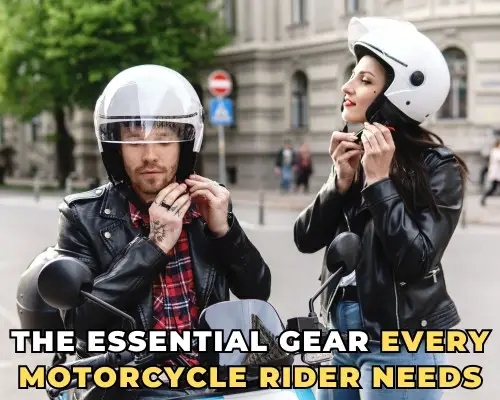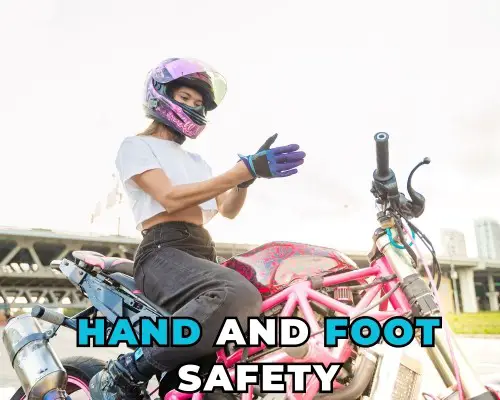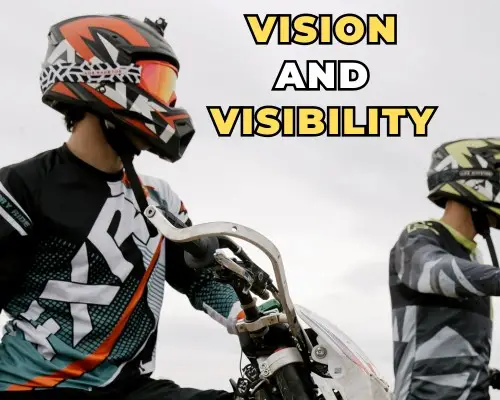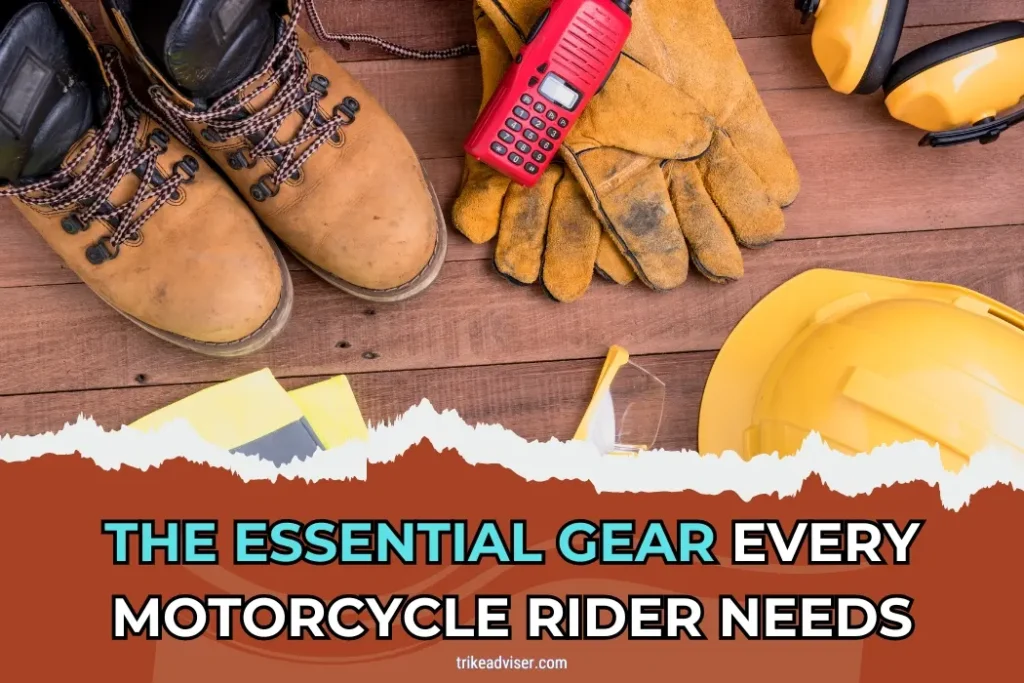Riding without the right gear? It’s like frying bacon shirtless, pain guaranteed. Ever seen a rider zip past, decked out head-to-toe, looking sharp and secure? That’s no accident.
Every motorcycle enthusiast, newbie or seasoned, faces this challenge: choosing the right gear. Helmet, jacket, gloves—essential, yet overwhelming to select.
Why? Safety isn’t a ‘maybe,’ it’s a must. Road rash, windburn, or worse, accidents—common fears that turn thrilling rides into nerve-wracking thoughts.
Let’s cut through the confusion. Whether dodging urban traffic or cruising coastal roads, you need protection.
Gear up right, and riding becomes not just safer but significantly more enjoyable. So, what exactly should every rider, beyond the reckless ‘squids,’ actually wear?
The Essential Gear Every Motorcycle Rider (NOT Just Squids) Needs

Sturdy Stands
Just like my old Scout leader used to say, “Leave it better than you found it.” This goes for parking your bike too.
Good stands not only prevent tire flats—crucial for those who don’t ride daily—but also make routine maintenance a breeze.
I learned the hard way that skimping on stands means more hassle later. Invest in stands that won’t buckle under pressure; they’re worth every penny.
Reliable Tire Air Pressure Gauge
I still remember the first time I rode with under-inflated tires; the sluggish handling was a wake-up call. Regular checks before rides are essential for handling and fuel efficiency.
A reliable gauge can be the difference between a smooth ride and an unexpected pit stop. Look for one with a flexible hose and an easy-to-read dial.
Chain Maintenance Kit
Think of your chain as the lifeline of your motorcycle. At 300 miles, it begs for some TLC. I’ve seen a poorly maintained chain snap mid-ride—it wasn’t pretty.
Invest in a quality cleaner, a sturdy scrub brush, and a lubricant that doesn’t attract dirt. Your ride’s performance depends on it.
Torque Wrench
That feeling when you tighten a bolt just right—satisfying, isn’t it? But overdo it, and you’re looking at a stripped bolt and a real headache.
Whether it’s a basic oil change or adjusting the suspension, a torque wrench is crucial. I’ve had great success with both click-type and digital models. Remember, accurate torque ensures longevity and safety.
Compact Tire Repair Kit
Ever had a flat in the middle of nowhere? I have, and since then, I always carried a compact tire repair kit. Some kits come with air cartridges that can get you to the next station without the need for bulky compressors. Make sure yours includes easy-to-use plugs and enough cartridges for multiple repairs.
Carrying Bags
A wise rider once told me, “If you can’t carry it, you don’t need it.” But for the essentials, you need a good bag.
Tail bags, tank bags, or backpacks—choose based on your bike and your needs. Ensure it’s secure, waterproof, and doesn’t compromise your balance. A good bag makes all the difference in convenience and safety.
RV Coverage for Motorcycles
Stranded with your bike can turn an adventure into a nightmare. Regular insurance might cover just the basics.
With RV coverage, I once got towed over 90 miles back home—no extra charge. It’s peace of mind you can’t afford to skip, especially if you love long rides.
High Visibility Safety Vest
Low visibility is a biker’s worst enemy. A simple high-vis vest has made me feel safer on foggy mornings and dusky evenings.
It’s not just about being seen by others; it’s about knowing you’re doing all you can to stay safe. Plus, it’s essential if you’re stranded. Lightweight, easy to pack, and could save your life.
Power bank Jump starter
A dead battery stopped my ride on a chilly October evening. Ever since a power bank jump starter is as essential as my helmet.
Besides jumpstarting, it charges everything from phones to cameras. Most are compact and include LED lights for emergencies. Never ride without it.
Smartwatch with Cellular Function
Gone are the days of bulky pockets on rides. My smartwatch keeps me connected, monitors my heart rate, and even pays for gas with a tap.
It’s a game-changer for riders who want to stay light and agile. Plus, the health monitoring features are indispensable in case of an accident.
Head Protection – Choosing the Right Helmet

Types of Motorcycle Helmets:
Picking the right helmet is a personal saga, filled with trials and lots of error—trust me, I’ve been there.
- Full Face: This is your fortress on wheels. Covering your entire head and face, it’s the go-to for maximum safety. I remember a close call on a wet freeway; my full-face helmet was my only consolation—it kept my face dry and intact.
- Modular (Flip-up): These are for the indecisive adventurer. Flip up for a breath of fresh air or a quick chat. But here’s the catch: that flexibility comes with extra weight. Choose wisely if you’re sensitive to neck strain after long rides.
- Open Face (Three-Quarter): They say freedom feels good until you taste a bug at 60 mph. Open-face helmets offer that iconic look and more headroom, but they trade off safety. Perfect for a casual jaunt around town, not for the race track.
Features to Look For:
Finding the right features in a helmet is like packing for a weekend trip—what you take is crucial.
- Safety Ratings: More than just stickers—these are your lifeline. DOT, ECE, Snell—get familiar with these terms. They mean your helmet’s tough enough to protect you, not just decorate your head.
- Materials: Think of it like choosing between a steel vault and a wooden box. Polycarbonate, fiberglass, carbon fiber—each has its merits. Carbon fiber doesn’t just look sleek; it’s light and absorbs impact like a pro.
- Fit: Ever had a helmet that squeezed your temples but gapped at your cheeks? That’s a no-go. It should fit snugly all around—no pressure points. A good fit isn’t just about comfort; it’s about safety. It shouldn’t slide around when you shake your head.
- Visor Quality: A foggy visor on a chilly morning can make your ride nerve-wracking. Look for anti-fog technology and wide views. Riding isn’t just about looking ahead, it’s about seeing clearly.
- Ventilation: Ever felt like you’re breathing through a straw? That’s poor helmet ventilation for you. Good airflow keeps you cool and the visor clear. It’s not just comfort; it’s about maintaining alertness on long rides.
- Additional Safety Features: Like emergency cheek pad systems—because in a crisis, every second counts. MIPS technology is another lifesaver, literally. It helps reduce the rotational forces on your brain during an impact. Think of it as an airbag for your head.
The Lifespan of a Helmet and When to Replace It:
Your helmet isn’t eternal, and recognizing its retirement age is key.
- General Rule: Think of it like milk—there’s a freshness date. Three to five years is a standard guideline, but if you ride daily, lean towards three. Materials age, even if you can’t see it.
- Post-Impact: Just like you wouldn’t reuse a crushed car bumper, don’t reuse a helmet after a crash. It’s done its job. Thank it for its service and let it go.
- Signs of Wear: Check for less obvious signs of aging. Is the inner lining compressing? Are the straps fraying? These are signs it’s time for a new guardian for your grey matter.
- Environmental Factors: Stored your helmet on your bike under the sun? UV rays can degrade the materials faster. Keep it in a cool, dry place when not in use. Treat it like something precious—because it is.
Hand and Foot Safety – Gloves and Boots

Choosing Gloves
Gloves are not just another accessory—they are a rider’s first line of defense. In my years on two wheels, I’ve learned that cutting corners on hand protection can lead to regret.
- Material: Leather is a rider’s best friend. It’s saved my skin more times than I can count, literally. High-grade synthetics can also provide good protection, but nothing beats leather for its abrasion-resistant qualities.
Ensure the critical areas like palms and fingers are reinforced, ideally with materials that slide rather than catch on the pavement.
- Fit: I once had a pair of gloves that were too loose; they fluttered like flags on a windy day. A snug fit is crucial, as it ensures that the gloves stay in place during a slide and gives you the necessary tactile feedback for operating controls. They should allow full dexterity without any pinch points.
- Protection Levels: Look for gloves with robust padding and armor. My current pair has carbon fiber knuckle guards—a blessing when you accidentally brush against a side mirror in heavy traffic. These materials shouldn’t just protect; they should dissipate the force of impacts.
- Additional Features: I never ride without touchscreen-compatible gloves. It’s not a luxury; it’s about not having to pull over to use my phone safely.
Also, ventilation is a must for summer rides, and for all-season riders, don’t skimp on waterproofing features.
The Significance of Sturdy Motorcycle Boots
Boots do more than complete the look—they’re your bike’s best companions for transferring control inputs safely and effectively.
- Protection: Remember, boots are not just for walking. They need to handle high impacts and resist crushing.
The boots I wear come with a rigid structure that supports the ankle and a sole designed to resist slipping, even on oil-slick surfaces.
- Fit: Motorcycle boots should be snug enough to prevent shifting but not so tight as to restrict blood flow.
Check that you can still wiggle your toes. Adequate ankle support is crucial for preventing twists in a crash, which I’ve found invaluable during unexpected dismounts.
- Safety Standards: Always check for the EN13634 certification when choosing boots. This standard ensures that the boots have undergone rigorous testing for all kinds of stresses typical in motorcycle accidents. It’s not just a label; it’s your peace of mind.
Waterproof and Weather-Resistant Options for All-Season Riding
Adapting to the elements is part of the ride. Here’s how to stay comfortable in any weather:
- Material: My boots are Gore-Tex, which has been a game-changer for keeping dry without feeling like I’m wearing plastic bags on my feet. They’re breathable and completely waterproof, ideal for those unexpected downpours.
- Insulation: On a cold ride across Nevada last November, my insulated boots were worth their weight in gold. They help preserve core body heat, which keeps your whole body warmer.
- Ventilation: When it heats up, ventilation is not just about comfort; it’s about safety. Overheating can cause fatigue, and fatigue causes mistakes. Look for boots with strategic ventilation to keep cool but protected.
Vision and Visibility – Eye Gear and Reflective Clothing

Benefits of Motorcycle Goggles and Visors
Good visibility isn’t a luxury; it’s a must. I learned that the hard way on a dusk ride that quickly turned into a night journey.
- Protection from the Elements: Remember the time a bug hit my eye at 70 mph? I sure do. Motorcycle goggles and visors act as your first defense against whatever the road throws at you.
They guard against wind, rain, dust, and those unexpected bugs while shielding your eyes from UV rays that can tire you out on long sunny rides.
- Goggles: Versatile and effective, goggles fit snugly, wrapping around your face to seal out wind and debris completely.
They come in various styles to suit any rider’s taste and are particularly beneficial for those wearing open helmets.
Plus, they’re a blessing in sandy or dusty conditions where traditional visors might not seal as tightly.
- Visors: Integrating with your full-face helmet, visors offer a barrier against the world. On a bright day last summer, my tinted visor was a savior, cutting down the glare and letting me ride hours longer without squinting.
Switch to a clear visor at night to avoid reducing your visibility—seeing is crucial when headlights are your main light source.
High Visibility Gear and Its Impact on Safety
Ever been on a foggy morning ride? I have. And my high-vis jacket was what made motorists notice me.
- Enhancing Visibility: High-vis clothing is more than fashion; it’s a beacon for safety. Fluorescent colors and reflective strips catch the light, dramatically increasing your visibility. In dim light or poor weather conditions, this gear can be a lifesaver.
- Safety Regulations: It’s not just about preference; in many regions, wearing high-visibility gear is part of road safety laws, especially for professionals like couriers and road workers.
These pieces are engineered to meet strict safety standards, ensuring they reflect light effectively and stand out against any background.
- Choice of Colors: While neon yellow and blaze orange are the standards, neon greens, and even some reflective blues are becoming popular. They’re not just stylish—they’re designed to make you the most visible thing on the road.
Night Riding: Tips for Staying Visible
Night riding? It’s about planning. I deck out my bike and gear to light up like a Christmas tree—safely and effectively.
- Reflective Gear: Every piece of clothing should have reflective detailing. Reflective tapes aren’t just for the bike; they should be on your jacket, pants, and boots. They bounce back light from headlights, making you visible from all angles.
- Enhanced Motorcycle Lighting: Auxiliary lights aren’t just accessories; they’re essentials. Your bike’s LED lights improve road illumination and increase your visibility to other drivers.
You can put reflective tape on your bike’s sides and rear to make it flash brightly when passing cars pass by.
- Eye Gear for Night Riding: Clear visors or goggles are mandatory for night rides. They keep your vision clear without dimming your view.
Opt for models with anti-fog coatings to avoid the inside of the visor clouding up, which can happen on cooler nights, turning a ride risky.
As an Amazon Associate, I earn from qualifying purchases, at no additional cost to you. Read Our Affiliate Disclosure.

